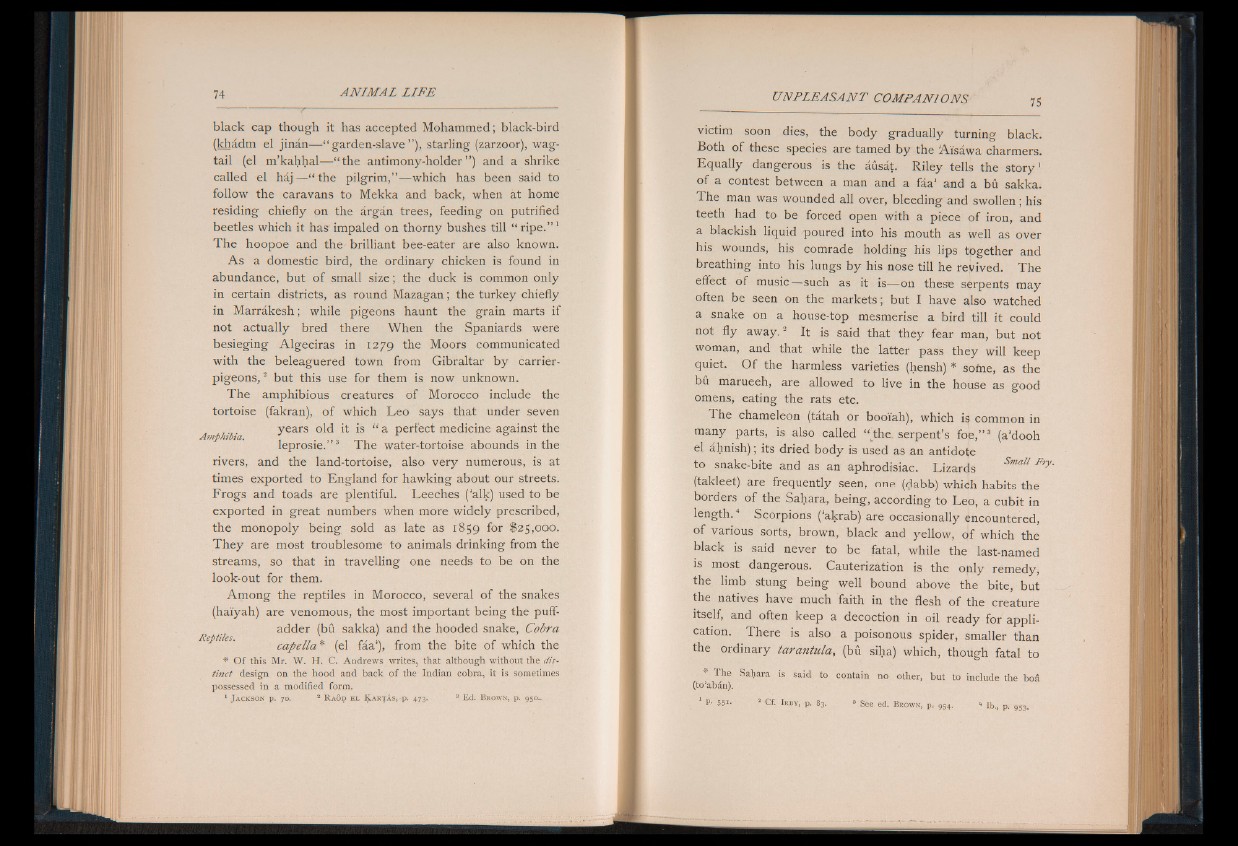
black cap though it has accepted Mohammed; black-bird
(khadm el jinan— “ garden-slave” ), starling (zarzoor), wagtail
(el m’kahhal— “ the antimony-holder” ) and a shrike
called el haj — “ the pilgrim,”— which has been said to
follow the caravans to Mekka and back, when at home
residing chiefly on the argan trees, feeding on putrified
beetles which it has' impaled on thorny bushes till “ ripe.” 1
The hoopoe and the brilliant bee-eater are also known.
A s a domestic bird, the ordinary chicken is found in
abundance, but o f small s ize; the duck is common only
in certain districts, as round Mazagan; the turkey chiefly
in Marrakesh; while pigeons haunt the grain marts if
not actually bred there When the Spaniards were
besieging Algeciras in 1279 the Moors communicated
with the beleaguered town from Gibraltar by carrier-
pigeons,3 but this use for them is now unknown.
The amphibious creatures of Morocco include the
tortoise (fakran), o f which Leo says that under seven
years old it is “ a perfect medicine against the
Amphibia. . . .
leprosie. The water-tortoise abounds in the
rivers, and the land-tortoise, also very numerous, is at
times exported to England for hawking about our streets.
Frogs and toads are plentiful. Leeches (’alk) used to be
exported in great numbers when more widely prescribed,
the monopoly being sold as late as 1859 for $25,000.
They are most troublesome to animals drinking from the
streams, so that in travelling one needs to be on the
look-out for them.
Among the reptiles in Morocco, several of the snakes
(haiyah) are venomous, the most important being the puffadder
(bu sakka) and the hooded snake, Cobra
Reptiles. ,
capella * (el faa'), from the bite of which the
* Of this Mr. W. H. C. Andrews writes, that although without the distinct
design on the hood and back of the Indian cobra, it is sometimes
possessed in a modified form.
1 J a c k s o n p . 70. 2 R a o d e l K a r t a s , -p . 473. 3 E d . B r o w n , p . 950...
victim soon dies, the body gradually turning black.
Both of these species are tamed by the Aisawa charmers.
Equally dangerous is the ausat. Riley tells the s to ry 1
of a contest between a man and a faa‘ and a bu sakka.
The man was wounded all over, bleeding and swollen; his
teeth had to be forced open with a piece of iron, and
a blackish liquid poured into his mouth as well as over
his wounds, his comrade holding his lips together and
breathing into his lungs by his nose till he revived. The
effect o f music— such as it is— on these serpents may
often be seen on the markets; but I have also watched
a snake on a house-top mesmerise a bird till it could
not fly away. | It is said that they fear man, but not
woman, and that while the latter pass they will keep
quiet. O f the harmless varieties (hensh) * some, as the
bu marueeh, are allowed to live in the house as good
omens, eating the rats etc.
The chameleon (tatah or booiah), which is common in
many parts, is also called “ the. serpent’s foe,” 3 (a'dooh
el ahnish); its dried body is used as an antidote
to snake-bite and as an aphrodisiac. Lizards SmaU Fry'
(takleet) are frequently seen, one (dabb) which habits the
borders of the Sahara, being, according to Leo, a cubit in
length. Scorpions ( akrab) are occasionally encountered,
of various sorts, brown, black and yellow, o f which the
black is said never to be fatal, while the last-named
is most dangerous. Cauterization is the only remedy,
the limb stung being well bound above the bite, but
the natives have much faith in the flesh of the creature
itself, and often keep a decoction in oil ready for application.
There is also a poisonous spider, smaller than
the ordinary tarantula, (bu siha) which, though fatal to
the Sahara is said to contain no other, but to include the boS
(tosab£n).
1 p ‘ 5S1* 2 Cf. I r b y , p. 83. 8 See ed. B r o w n , p* 954. * lb., p. 953.